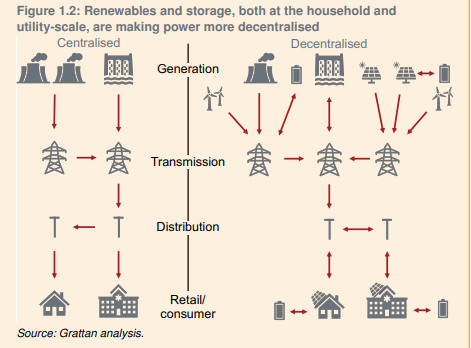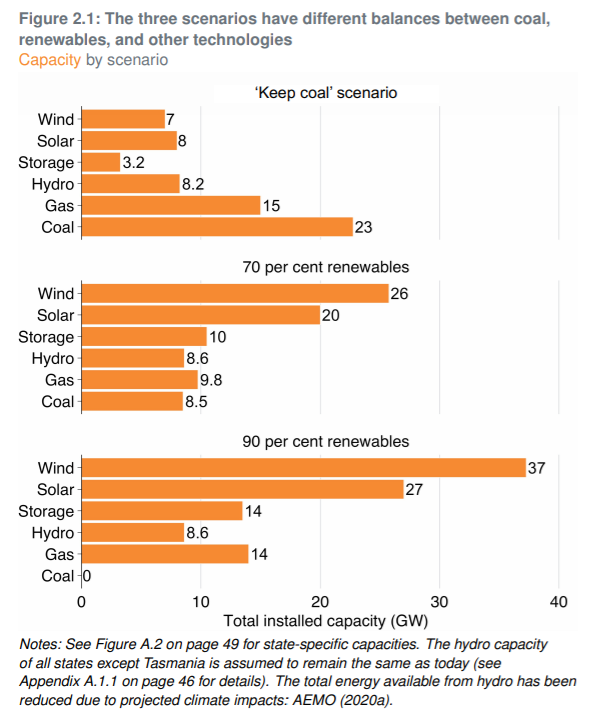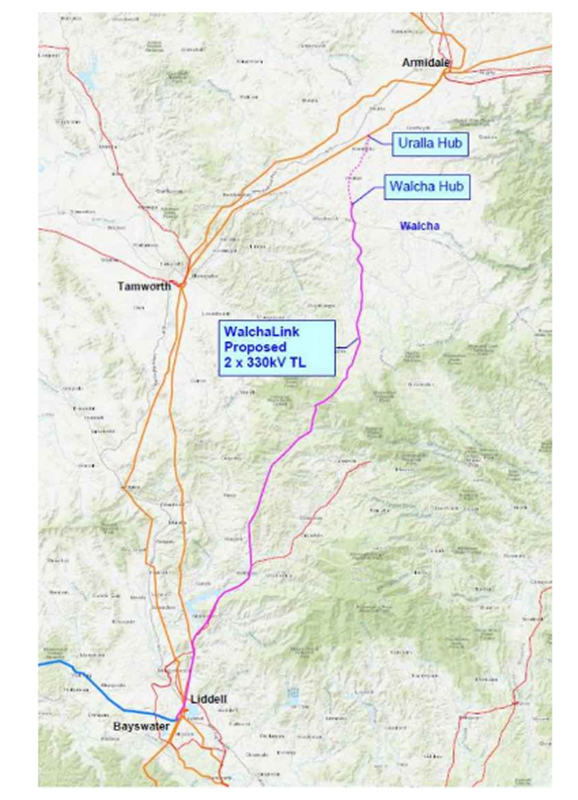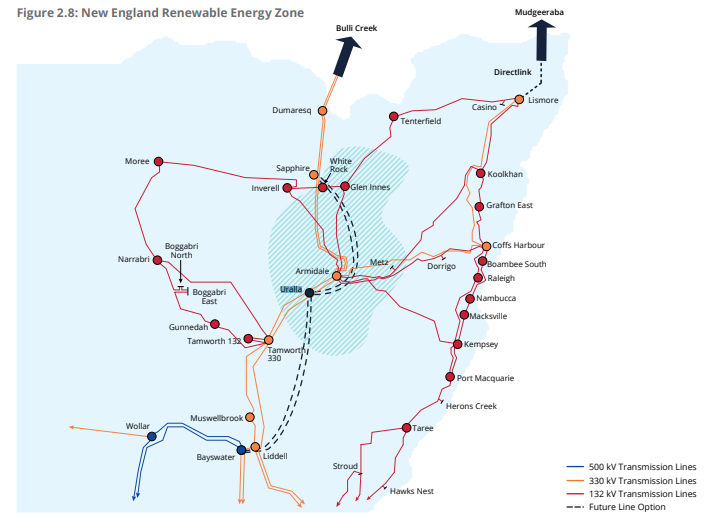Walcha gonna do about transmission?
Going for net zero in a measured way
The Grattan Institute recently released a Go for net zero report[1] which identifies a path to achieve net zero emissions while seeking to retain an acceptable electricity reliability though the transition.
The report provides three conclusions:
- Australian can achieve 70-90 per cent renewables with little risk to reliability or affordability, albeit achieving 90 per cent will be slightly more expensive.
- The value of an inter-connected grid grows as the proportion of renewables on the system grows. When there is less wind and sun to meet demand across the day; batteries, pumped hydro and gas fired generation will be important to meet demand.
- Moving from 90 per cent to 100 per cent renewables is not considered economically viable yet and is considered challenging to meet demand reliability.
Grattan’s Figure 1.2 depicts the few large generators connected to transmission and distribution networks that supply electricity customers in an orderly fashion. This is changing to a decentralised approach with many intermittent renewable generators, located in the resource rich areas suitable for pumped hydro or solar/wind generation. More transmission is needed to connect these generators which are in different locations than the retiring coal generators.
Rooftop solar and behind the meter batteries have had strong growth over the past decade, often supported by government initiatives and feed-in tariffs. Grattan finds that faster uptake of rooftop solar will push up system costs and make the operation of the power system more challenging. Importantly, this local generation does not undercut the need for more transmission. Cloudy days will continue to lower renewable energy output in different locations and a more interconnected grid will enable reliable renewable generation from other states where the sun is shining and the wind is blowing.
In Grattan’s ‘keep coal’ scenario, keeping today’s interstate transmission network is a lower-cost option than investing in an upgraded grid. But for Grattan’s 70 per cent RE’ and 90 per cent RE’ scenarios, investing in new transmission offers better value, reducing the cost of electricity overall, despite the additional cost of the upgrades. States are able to support each other to a greater extent, reducing the need for in-state dispatchable capacity. Less wind and solar energy is wasted.
Government policies support various state-based renewable energy targets and recognise that renewable energy strategies and transmission is needed for the transition. The Energy Security Board (ESB) was instrumental in developing the rule framework, which commenced on 1 July 2020, to underpin the national integrated system plan. In fact, governments are underwriting some of the early work on large interconnector projects identified in the national plan to help fast track regulatory approvals and project delivery.
Frustration with the national rules, governance arrangements and regulatory structures has led to many states derogating away from the rules to do their own thing. Grattan recommends governments recommitting to the National Electricity Market (NEM). A common framework for implementing renewable energy zones and providing access rights is being developed by the ESB. In contrast, some policies could be looking at three or more access models in a state. This complexity and the risk of how these models will transition to longer-term access reform, may not encourage investment by the private sector.
The ESB expects to release a draft options paper for the post 2025 reform in late April. The consultation paper will address these issues, hopefully with governments supporting the proposed way forward.
WalchaLink – going it alone?
A joint venture between Mirus Energy and Energy Estate, Walcha Energy aims to build a private transmission line, a 178km double circuit 330kV line from the retiring coal generation area at Liddell to Walcha Rd as indicated in the map below.[2] This new transmission and renewable zone is part of the development flagged in the AEMO 2020 ISP and in the NSW Electricity Strategy.
The TransGrid NSW Transmission Annual Planning Report (TAPR) recognises that the project may be progressed through NSW Government policy.[3] This New England REZ is also a future ISP project with TransGrid already undertaking preparatory activities to be reported by June 2021. The question is whether the project falls under the national ISP or regulated transmission delivery framework. Is the WalchaLink project a merchant link or will it be regulated by the emerging NSW policy?
The plan is to develop a mix of renewable energy connected along the line – about 3,400MW of wind generation capacity, up to 700MW solar and about 500MW[4] of multiple pumped hydro energy storage facilities. The generation potential is about 15 per cent of NSW electricity demand, more than the Liddell output. This recent announcement to build a private line is the next step. The Walcha Energy website suggests construction is planned to start in 2021 with the first generation by 2023.[5]
This appears to be a generator-led development, meaning Walcha Energy pays for the development which is essentially funded at a commercial return, possibly over the life of the generation assets and charged initially to the connecting generators. While electricity customers would not pay for this as part of transmission charges, the costs will still be incorporated into the retail electricity bill.
Energy Users Association of Australia welcomes the generator led investment as Walcha Energy would bear the risks and costs of the asset or the benefits.[6] If the asset is underutilised then it is not electricity consumers who bear the asset stranding risk. It will be interesting to see if this is a truly merchant link or whether NSW Government funding is sought to underpin the construction of the transmission line. If it is the latter, this is likely to be charged to NSW distribution networks to pass to consumers as set up in the NSW Electricity Infrastructure legislation.
New transmission, subject to rigorous and transparent cost/benefit test, will enable greater competition between generators in the NEM and place downward pressure on wholesale electricity prices. There is benefit if states coordinate their policy approaches to facilitate a consistent approach to the implementation of renewable energy zones. It is important for governments and other stakeholders to engage in the ESB processes to develop a common framework for this transition.
[1] https://grattan.edu.au/wp-content/uploads/2021/04/Go-for-net-zero-Grattan-Report.pdf
[2] RenewEconomy, Walcha Energy proposes to go it alone on major NSW transmission link, Sophie Vorrath, 7 April 2021
[3] TransGrid, NSW Transmission Annual Planning Report 2020, p30
[4] http://www.walchaenergy.com.au/the-project.html
[5] http://www.walchaenergy.com.au/the-project.html
[6] EUAA press release, Walcha Link could be a game changer, 8 April 2021





